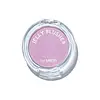What's inside
What's inside
 Key Ingredients
Key Ingredients

 Benefits
Benefits

No benefits
 Concerns
Concerns

 Ingredients Side-by-side
Ingredients Side-by-side

CI 77891
Cosmetic ColorantPolymethyl Methacrylate
Dimethicone
EmollientDimethicone/Vinyl Dimethicone Crosspolymer
Skin ConditioningDiphenylsiloxy Phenyl Trimethicone
Skin ConditioningMica
Cosmetic ColorantPhenyl Trimethicone
Skin ConditioningHydrogenated Poly(C6-14 Olefin)
EmollientDiisostearyl Malate
EmollientSilica
AbrasiveSynthetic Fluorphlogopite
Polymethylsilsesquioxane
Caprylyl Glycol
EmollientGlyceryl Caprylate
EmollientCI 75470
Cosmetic ColorantTriethoxycaprylylsilane
Aluminum Hydroxide
EmollientLauroyl Lysine
Skin ConditioningCI 77510
Cosmetic ColorantTin Oxide
AbrasiveTocopherol
AntioxidantCI 77891, Polymethyl Methacrylate, Dimethicone, Dimethicone/Vinyl Dimethicone Crosspolymer, Diphenylsiloxy Phenyl Trimethicone, Mica, Phenyl Trimethicone, Hydrogenated Poly(C6-14 Olefin), Diisostearyl Malate, Silica, Synthetic Fluorphlogopite, Polymethylsilsesquioxane, Caprylyl Glycol, Glyceryl Caprylate, CI 75470, Triethoxycaprylylsilane, Aluminum Hydroxide, Lauroyl Lysine, CI 77510, Tin Oxide, Tocopherol
Talc
AbrasiveMica
Cosmetic ColorantDimethicone
EmollientMethyl Methacrylate Crosspolymer
Zinc Stearate
Cosmetic ColorantSynthetic Fluorphlogopite
Pentylene Glycol
Skin ConditioningLauroyl Lysine
Skin ConditioningSodium Dehydroacetate
PreservativeCaprylyl Glycol
EmollientParfum
MaskingCitronellol
PerfumingCI 15850
Cosmetic ColorantCI 15985
Cosmetic ColorantCI 19140
Cosmetic ColorantCI 42090
Cosmetic ColorantCI 45410
Cosmetic ColorantCI 73360
Cosmetic ColorantCI 77007
Cosmetic ColorantCI 77163
Cosmetic ColorantCI 77288
Cosmetic ColorantCI 77289
Cosmetic ColorantCI 77491
Cosmetic ColorantCI 77492
Cosmetic ColorantCI 77499
Cosmetic ColorantCI 77510
Cosmetic ColorantCI 77742
Cosmetic ColorantCI 77891
Cosmetic ColorantTalc, Mica, Dimethicone, Methyl Methacrylate Crosspolymer, Zinc Stearate, Synthetic Fluorphlogopite, Pentylene Glycol, Lauroyl Lysine, Sodium Dehydroacetate, Caprylyl Glycol, Parfum, Citronellol, CI 15850, CI 15985, CI 19140, CI 42090, CI 45410, CI 73360, CI 77007, CI 77163, CI 77288, CI 77289, CI 77491, CI 77492, CI 77499, CI 77510, CI 77742, CI 77891
 Reviews
Reviews

Ingredients Explained
These ingredients are found in both products.
Ingredients higher up in an ingredient list are typically present in a larger amount.
Caprylyl Glycol is a humectant and emollient, meaning it attracts and preserves moisture.
It is a common ingredient in many products, especially those designed to hydrate skin. The primary benefits are retaining moisture, skin softening, and promoting a healthy skin barrier.
Though Caprylyl Glycol is an alcohol derived from fatty acids, it is not the kind that can dry out skin.
This ingredient is also used as a preservative to extend the life of products. It has slight antimicrobial properties.
Learn more about Caprylyl GlycolThis ingredient is used to impart a blue color. It is not water-soluble.
It goes by two different names:
1. Ferric Ferrocyanide: a synthetic dark blue pigment
2. Ferric Ammonium Ferrocyanide: a synthetic blue pigment, also called Prussian blue
In the EU, both of these colors must be labeled as 'CI 77510'.
Learn more about CI 77510Ci 77891 is a white pigment from Titanium dioxide. It is naturally found in minerals such as rutile and ilmenite.
It's main function is to add a white color to cosmetics. It can also be mixed with other colors to create different shades.
Ci 77891 is commonly found in sunscreens due to its ability to block UV rays.
Learn more about CI 77891Dimethicone is a type of synthetic silicone created from natural materials such as quartz.
What it does:
Dimethicone comes in different viscosities:
Depending on the viscosity, dimethicone has different properties.
Ingredients lists don't always show which type is used, so we recommend reaching out to the brand if you have questions about the viscosity.
This ingredient is unlikely to cause irritation because it does not get absorbed into skin. However, people with silicone allergies should be careful about using this ingredient.
Note: Dimethicone may contribute to pilling. This is because it is not oil or water soluble, so pilling may occur when layered with products. When mixed with heavy oils in a formula, the outcome is also quite greasy.
Learn more about DimethiconeThis ingredient comes from a fatty acid (lauric acid) and amino acid (lysine). It is used to add a silky feel to cosmetics.
According to a manufacturer, its fatty acid base leaves a silky feeling on the skin. It also has emollient properties because of this. Emollients help soften skin by preventing water from evaporating.
Lauroyl lysine is barely soluble in water.
Learn more about Lauroyl LysineMica is a naturally occurring mineral used to add shimmer and color in cosmetics. It can also help improve the texture of a product or give it an opaque, white/silver color.
Serecite is the name for very fine but ragged grains of mica.
This ingredient is often coated with metal oxides like titanium dioxide. Trace amounts of heavy metals may be found in mica, but these metals are not harmful in our personal products.
Mica has been used since prehistoric times throughout the world. Ancient Egyptian, Indian, Greek, Roman, Aztec, and Chinese civilizations have used mica.
Learn more about MicaSynthetic Fluorphlogopite is the synthethic version of mica. It consists of fluorine, aluminum and silicate.
Synthetic Fluorphlogopite is used to add volume to products.
It is considered non-irritating on the skin.
Learn more about Synthetic Fluorphlogopite